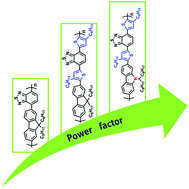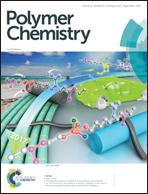The effect of the backbone structure on the thermoelectric properties of donor–acceptor conjugated polymers†
Abstract
Three donor–acceptor (D–A)-structured conjugated polymers with different backbones, poly((9,9-dioctylfluorene)-2,7-diyl-alt-benzothiadiazole) (F8BT), poly((9,9-dioctylfluorene)-2,7-diyl-alt-(4,7-bis(3-hexylthien-5-yl)-2,1,3-benzothiadiazole)-2′,2′′-diyl) (F8TBT), and poly(N-9′-heptadecanyl-2,7-carbazole-alt-(4,7-bis(3-hexylthien-5-yl)-2,1,3-benzothiadiazole)-2′,2′′-diyl) (C8TBT), were synthesized via conventional Suzuki polymerization. All three polymers showed good thermal and electrochemical stabilities. The UV-vis absorption spectra indicated that the introduction of thiophene units into the polymer backbone decreased the bandgap of the polymers. When the three polymer films were doped with FeCl3, different thermoelectric properties were observed. F8TBT and C8TBT, which contained thiophene units, showed a higher electrical conductivity than F8BT. As the temperature increased, C8TBT exhibited the highest Seebeck coefficient of 335 μV K−1 at 90 °C and a maximum power factor of 13.11 μW m−1 K−2. These results demonstrated that the polymer backbone structure greatly influences the thermoelectric properties and the inclusion of thiophene and carbazole units can effectively improve the thermoelectric properties. Therefore, this work is a novel and important reference to design and synthesize high-performance thermoelectric conjugated polymers.



 Please wait while we load your content...
Please wait while we load your content...